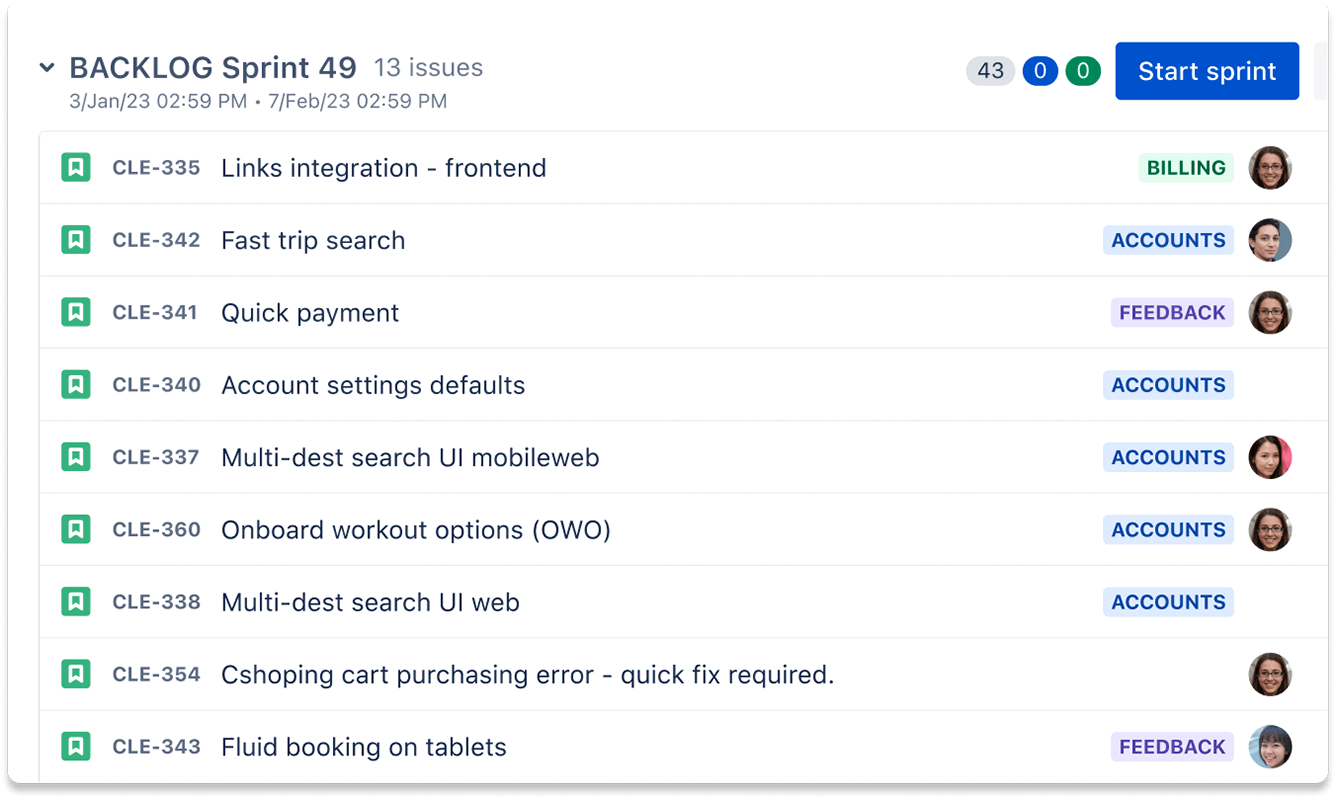Sprint 待办事项可让团队在 Scrum 冲刺(是指分配的用于完成工作的时间段)阶段保持专注。它是团队在冲刺阶段使用的任务列表,有助于防止范围蔓延。那是因为它们允许您确定要执行的任务的优先顺序。在冲刺规划期间,会为 Scrum 冲刺选择高优先级任务。任务来自产品待办项目,而后者是在待办事项列表梳理过程中确定优先顺序的。
了解 Sprint 待办事项的用途

Sprint 待办事项概述了项目团队在冲刺阶段的具体任务和活动。它根据产品待办事项来提取项目,这也是待办事项列表优化至关重要的原因所在。如果没有妥善维护的待办事项列表,您就有可能处理的是与客户或产品路线图无关的项目。
“以客户为中心至关重要,团队必须把客户重点放在待办事项列表梳理上,”Atlassian 的高级技术宣传专员 Warren Marusiak 说。“在下一个冲刺阶段,我们可以为客户提供什么价值?在接下来的五个冲刺阶段,我们可以提供什么价值?这如何实现我们的长期目标?”
团队使用产品待办事项及其当前的工作量来确定哪些任务可以在冲刺的时间范围内完成。一旦某项任务被认为可执行,它就会移至 Sprint 待办事项。如果它太大,则会将其分解为较小的任务并在多个冲刺阶段执行。在较小时间段的冲刺内工作有助于团队保持敏捷。
可以将 Sprint 待办事项想象成团队针对该特定冲刺的行动计划。它可使团队步入正轨,专注于实现冲刺的目标。在每日冲刺审查期间,项目经理会评估他们的团队是否达到目标,并在此过程中庆祝取得的成绩。
Sprint 待办事项与产品待办事项:差异说明
尽管“Sprint 待办事项”和“产品待办事项”这两个术语听起来很相似,但它们却大不相同。让我们来看一看 Sprint 待办事项可能包含哪些内容,以及它与产品待办事项有何不同。
| 产品待办事项 | 冲刺待办事项 |
| 产品待办事项是给定产品中要包含的项目清单,例如新功能、客户请求、缺陷修复和其他改进。 | Sprint 待办事项包含产品待办事项中的特定项目,因此是产品待办事项的一个子集。您的团队选择要在冲刺中处理的产品待办事项,然后将其放入 Sprint 待办事项中。 |
| 业务需求和目标决定了产品待办事项中项目的优先级。 | 团队速度和冲刺目标决定了 Sprint 待办事项中项目的优先级。 |
| 产品负责人拥有产品待办事项。 | 开发团队拥有并维护 Sprint 待办事项。 |
| 产品待办事项构成产品长期战略计划的一部分,并随着产品而演变。 | Sprint 待办事项是一项短期计划,用于在冲刺中完成一系列任务。在冲刺期间,团队无法对其进行更改。 |
| 产品待办事项的范围涵盖整个产品。 | Sprint 待办事项的范围是冲刺中包含的产品待办事项的子集。 |
Sprint 待办事项是根据产品待办事项创建的,因此,如果没有产品待办事项,Sprint 待办事项就不存在。在每次冲刺规划会议上,项目经理及其团队都会与产品经理讨论待办事项列表项目的优先级。然后,团队会确定行动计划,以交付 Sprint 待办事项中包含的项目。
使用 Sprint 待办事项的好处
对于项目经理,尤其是采用敏捷开发方法(例如 Scrum)的项目经理而言,Sprint 待办事项是一个非常强大的工具。如果您是 Scrum 教练,会发现 Sprint 待办事项对于组织和管理团队的工作量很有用。
我们来详细了解一下 Sprint 待办事项的好处:
- 提高估算精度:作为一项行动计划,Sprint 待办事项可帮助制定更准确的时间表并对可交付成果做出更准确的预估。这样可以避免设定不合理的截止时间,以免给您的团队带来压力。
- 提高工作效率:如果团队设定可实现的目标,承受的压力会减小,因为这些目标可以帮助他们集中精力,提高工作效率。
- 改进对未来冲刺的预测:团队可以分析他们在冲刺中完成任务的能力,帮助他们准确预测在未来冲刺中可以处理的工作量。
-
提高责任感:团队参与冲刺规划流程。他们根据自己的能力就 Sprint 待办事项中的任务达成一致,这让他们能自主掌控工作。
Sprint 待办事项的关键组成部分
现在我们来看看 Sprint 待办事项的具体组成部分。
用户故事
用户故事说明了某项功能将为最终用户带来的好处。用户故事非常简单,没有过于专业的技术术语,可说明用户将如何使用该功能。这说明了项目被列入待办事项的原因。
用户故事为开发团队提供了有关产品对用户影响的关键信息,有助于团队了解构建内容的背景和原因。任一敏捷开发方法的关键组成部分都是人,而用户故事注重使用产品或服务的人。
任务和子任务
任务根据用户故事创建,每个任务可能包含许多子任务。这些任务是完成用户故事所需的活动。例如,一项新功能可能需要用户执行多个步骤。每个步骤所需的功能可以转化为任务(以及为更复杂的步骤添加的子任务)。
每项任务和子任务都包括名称、描述、优先级、经办人、可交付成果列表和截止时间。例如,如果您的团队正在为某款社交应用开发评论功能,则您的任务列表可能如下所示:
| 任务 | 创建评论功能 |
| 描述 | 允许用户对帖子发表评论 |
| 优先级 | 高 |
| 经办人 | Lanisha,设计师 Roland,开发人员 |
| 可交付成果 | 评论框 |
| 到期时间 | 8 月 24 日 |
技术障碍
技术障碍是团队在开发产品时可能遇到的危险,例如技术债务或缺陷。技术债务是开发团队为确保产品正常运行而处理的必要维护和缺陷。
这些问题可能会在开发或测试期间出现,从而拖慢团队速度。您可能需要添加任务或子任务,才能扫清此障碍。
在 Scrum 中,它们也称为障碍。
经办人
团队速度是冲刺规划的主要组成部分,它会影响团队将哪些任务纳入 Sprint 待办事项。将任务加入待办事项列表后,需要一个负责人来执行 Sprint 待办事项中的工作以完成任务。
Sprint 待办事项设置了问责制和责任,以确保团队完成每项任务。
燃尽图
燃尽图可直观呈现已完成的工作和剩余工作。该图表是一个便于查看的进度图,因此非常有用。项目团队可以通过此图表来查看他们是否达成了目标,并绘制预估完成时间图。
燃尽图有助于确定团队当前的工作量过重还是过轻。它还可以突出显示预估时间与实际完成时间之间的差异。您可以在 Jira 中轻松创建燃尽图。
预估时间和实际时间
燃尽图有助于直观呈现任务的分配时间与其完成时间。在冲刺期间,项目经理每天都可对此进行跟踪。
每天,您可以分析团队完成一项任务所需的时间,将该时间与最初的预估时间进行比较,并将这些信息记录在燃尽图上。这种时间跟踪有助于确保团队遵照计划,满足截止时间要求。
如何创建 Sprint 待办事项
冲刺是在指定的时间范围内进行的,因此项目团队需要利用明确的待办事项列表来确保他们按计划完成任务。功能强大的 Sprint 待办事项可确保工作能够并且将会在规定时间段内完成。
下面介绍了如何创建功能强大的 Sprint 待办事项:
1. 确定冲刺目标
由于冲刺需要持续一段固定的时间,因此务必首先确定冲刺目标。Sprint 待办事项应包括为团队设定的明确目标,这有助于确保团队集中精力,专注于完成任务。Sprint 待办事项还可以防止范围蔓延。确保目标具体明确,并且可以在冲刺的时间范围内完成。
2. 与团队讨论待办事项列表
协作对于创建有效的 Sprint 待办事项至关重要。冲刺规划会议是与团队讨论待办事项的绝佳时机。您需要让团队成员认同他们将要完成的任务。这也有助于让他们对项目产生主人翁意识。
根据他们当前的速度和技术能力,充分发挥他们在完成任务方面的专业知识。冲刺规划会议模板对于组织这些会议非常有用。
3. 整理任务并确定其优先级
整理任务和确定任务的优先级对于帮助您的团队专注于最重要的方面至关重要。要整理待办事项列表中的任务并确定其优先级,请从用户故事入手。从这些故事中,团队可以确定高优先级任务。确定优先级后,您可以根据所有其他任务在用户故事中的重要性对其进行排序。一旦团队确定了任务的优先级,他们就可以进一步将其分解为子任务。
4. 监控并根据需要进行更新
项目经理监控团队的进度,以评估团队冲刺是否进展顺利。然后,他们可以根据需要对流程做出改进。这一点至关重要,因为在冲刺期间,团队的工作量可能会太多或不足。每日冲刺审查和立会可确保每个人都知道各个团队成员正在开展的工作,并帮助发现团队中的瓶颈。这使团队成员能够在必要时互相帮助,按时交付任务。
Jira 的 Scrum 模板包含多种工具,可帮助您有效规划冲刺。还有一个有用的教程页面,其中介绍了如何开始使用 Jira 创建 Sprint 待办事项。在冲刺规划会议期间优化待办事项列表后,您的任务将更加详细,可能如下所示:
| 任务 | 创建评论功能 |
| 描述 | 用户想对朋友的帖子发表评论和做出回应。 |
| 优先级 | 高 |
| 工作量水平 | 适度 |
| 所需时间 | 2 天 |
| 经办人 | Lanisha,设计师 Roland,开发人员 |
| 可交付成果 | 评论框 |
| 到期时间 | 8 月 24 日 |
关于管理 Sprint 待办事项的提示
对团队来说,管理 Sprint 待办事项与管理产品待办事项同样重要。两者都可防止团队处理与产品或客户无关的任务。要有效管理 Sprint 待办事项,项目经理需要不断征求团队意见,分析团队的流程并监控他们的进度。Jira 的 Scrum 模板可助您轻松管理待办事项列表。
以下是一些可帮助有效管理 Sprint 待办事项的提示:
- 征求团队成员的意见。从冲刺规划的早期阶段开始,征求团队的意见至关重要。团队成员在冲刺期间对任务的投入会在团队中形成主人翁意识。
- 使用完成的定义。每一次冲刺都必须有坚定、明确和切合实际的完成标准。这可让团队对任务何时完成做到心中有数。
- 简化流程。全程分析工作流和工作量,以简化下一次冲刺的流程。
-
保持待办事项列表的灵活性。虽然缓解范围蔓延至关重要,但也会出现问题,并且为了处理问题,待办事项列表必须足够灵活。
使用 Jira 更好地管理 Sprint 待办事项
Sprint 待办事项可以帮助您在冲刺之前、期间和之后组织团队的工作。如果得到有效利用,它们可以帮助您准确预测未来的冲刺并管理预期。精心设计和维护的 Sprint 待办事项可以提高冲刺效率。
Jira 可帮助您轻松优化待办事项列表和冲刺规划。使用 Jira 的 Scrum 模板快速设置下一个软件项目,并可视化、管理和跟踪从一个冲刺到另一个冲刺的工作。轻松创建 Scrum 待办事项列表以建立事务队列并开始规划和执行冲刺。
Sprint 待办事项:常见问题
谁对 Sprint 待办事项负责?
Sprint 待办事项由整个开发团队负责。这种共享所有权需要产品负责人、项目经理和冲刺团队共同献言献策。所有人协作确定哪些产品待办事项任务应移至 Sprint 待办事项。然后,团队为可交付成果和任务完成设定切合实际的截止时间。
何时应该使用 Sprint 待办事项?
Sprint 待办事项是冲刺规划的一部分。但是,您的使用频率将取决于冲刺的时长,不仅如此,您公司的各个团队之间对它的使用也可能有所不同。但是,如果您使用的是敏捷开发方法,那么最佳做法是在您规划的每个冲刺中都使用 Sprint 待办事项。
您应该多久更新一次 Sprint 待办事项?
应该每天更新一次。Sprint 待办事项可帮助您持续监控团队的进度。您可以协调完成每项任务的预估时间和实际时间,从而确保您的团队完成任务,并帮助您决定是否需要进行任何调整。